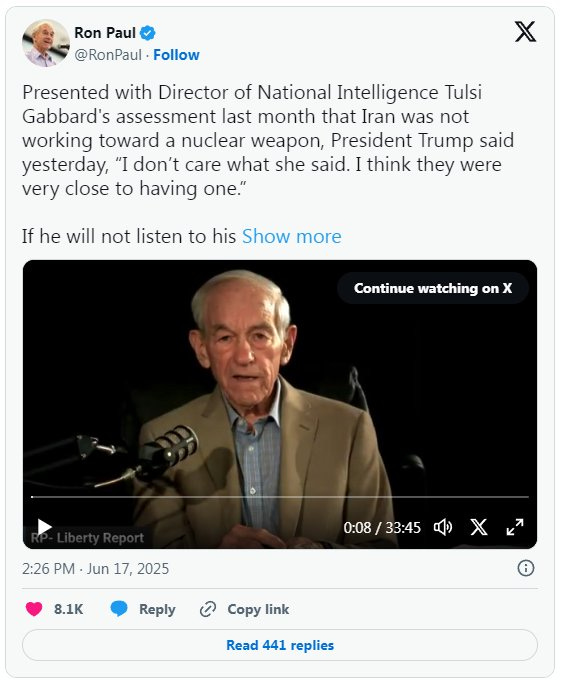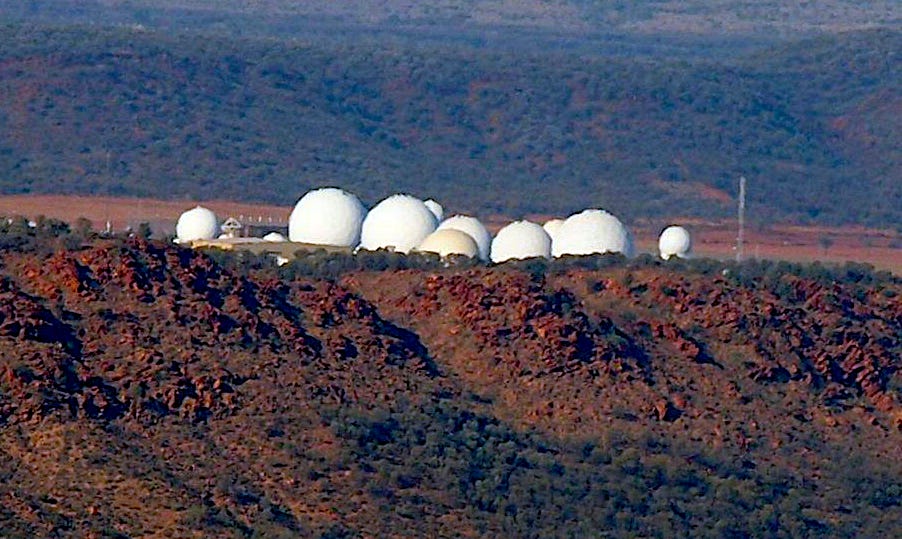Peter Cronau on a 2009 Brookings policy paper outlining how Washington could use Israel to wage war on Iran while justifying it with a false narrative of failed nuclear negotiations.
Declassified Australia
Controlling the narrative includes killing journalists. Iran’s state TV and radio broadcaster, Islamic Republic of Iran Broadcasting, in the nation’s capital Tehran, was bombed by Israel. A bloodied journalist reported from the street outside as the building burned. (IRIB via Declassified Australia)
A plan was developed for the United States to use diplomacy to entice Iran into negotiations that then fail, so Iran can be attacked while the U.S. is pushing a false narrative saying the Iranians “brought it on themselves.”
The plan also urged the U.S. to encourage or assist the Israelis, as a direct U.S. proxy, to conduct the strikes on Iran so as to deflect criticism and retaliation onto Israel, as Declassified Australia reports.
The audacious plan for a “plausibly deniable” war is detailed in an analysis flippantly titled “Leave It To Bibi: Allowing or Encouraging an Israeli Military Strike,” published in a report named Which Path To Persia: Options for a New American Strategy Towards Iran by the Brookings Institution, a longstanding Washington, D.C., think tank.
The plan, recently reviewed by strategic analyst Brian Bertelec, no doubt since perfected after being written in 2009 following the invasion and occupation of Iraq and Afghanistan, outlines options for a new venture by the U.S. this time, to counter Iran.
The U.S. intelligence community is well served by the plan’s authors. They include liberal “war hawks” and propagandists for U.S. Middle East policy, Kenneth Pollack who is a former Iraq and Iran military analyst at the C.I.A. and adviser at the White House; Bruce Riedel a 30-year veteran of the C.I.A. and a Middle East presidential adviser; and Daniel Byman a former C.I.A. analyst on Middle East terrorism.
Another of the report’s authors is a one-time Australian citizen and intelligence analyst with Australia’s Office of National Assessment (ONA), Martin Indyk, who moved to the U.S. and served twice as U.S. Ambassador to Israel, and who became a leading pro-Israel lobbyist.
The late Martin Indyk, then U.S. ambassador to Israel, with Israeli Foreign Minister Shimon Peres, undated. (U.S. Embassy in Jerusalem/Flickr/CC BY 2.0)
The report’s chapters cover options to topple the Iranian government that include supporting a military coup, an insurgency by opposition groups, a popular uprising, an invasion and a campaign of air strikes.
For the military campaign against Iran the report describes the goal is to deflect any retaliation and international blame for a military attack onto Israel: “The U.S. would encourage, and perhaps even assist, the Israelis in conducting the strikes [on the Iranian nuclear facilities] themselves, in the expectation that both international and Iranian retaliation would be deflected away from the United States and onto Israel.” [p.89]
In laying the groundwork for a public relations justification for the attack on Iran, the report proposes a false narrative of “failed peace talks”: “The best way to minimize international opprobrium and maximize support (however, grudging or covert) is to strike only when there is a widespread conviction that the Iranians were given but then rejected a superb offer, one so good that only a regime determined to acquire nuclear weapons and acquire them for the wrong reasons would turn it down.
“Under those circumstances, the United States (or Israel) could portray its operations as taken in sorrow, not anger, and at least some in the international community would conclude that the Iranians “brought it on themselves” by refusing a very good deal.” [p.39]
The deception and psychological warfare element, supporting Israel’s decapitation strikes against Iran, involved crafting false narratives to mislead Iran, like the now-abandoned nuclear talks between the U.S. and Iran. This element induced Iran to suspect infiltrators in their midst and to misjudge intentions, capabilities and timing, so exploiting Iran’s vulnerabilities.
And so it goes. The plan of strategic surprise is being executed almost verbatim.
After 60 days of hopeful but inconclusive talks between the U.S. and Iran over the fate of Iran’s nuclear research program, and a few days before those talks were due to recommence, Israel commenced a surprise series of bombing attacks on Iran on Friday the 13th of June. Targets of the pre-emptive strikes included Iranian military and nuclear facilities, killing nuclear scientists, military figures, and civilians.
Now, at the time of the writing of this article, the Israeli-initiated bombing of Iran and Iran’s defensive response, continues. The U.S. and the U.K. reportedly are amassing planes, ships and personnel at close readiness for possibly joining in the war against Iran.
The Iran ‘Threat’
The “Leave It To Bibi” plan was written at a time when Western intelligence agencies knew that Iran’s defenses were purely “defensive” and designed to resist attack by Israel and the United States.
Australia’s intelligence agencies have reported that, despite there being “strong indicators that Tehran’s preferred end state included a nuclear arsenal,” Iran’s position was essentially defensive, as Dr. Clinton Fernandes wrote in his book Sub-imperial Power.
The then director-general of Australia’s top spy agency, the Office of National Assessments (ONA), Peter Varghese, said in a classified U.S. embassy cable of an intelligence exchange in 2008 between Australia and the U.S. that was leaked to WikiLeaks, that: “ONA viewed Tehran’s nuclear program within the paradigm of ‘the laws of deterrence’.”
Australia’s top spy chief concluded by telling the intelligence briefing to U.S. embassy officials in Canberra, that ONA stated its position: “It’s a mistake to think of Iran as a ‘Rogue State’.”
Supporting this view was the director of the U.S. Defense Intelligence Agency (DIA), Lieutenant General Ronald L. Burgess, who in 2010 said Iran has a “defensive” military stance, reflected in its defense spending priorities: “This reflects its defensive military doctrine, which is designed to slow an invasion and force a diplomatic solution to hostilities. Iranian military training and public statements echo this defensive doctrine.
Its principles of military strategy include deterrence, asymmetrical retaliation, and attrition warfare.
Iran’s military strategy is designed to defend against external threats, particularly from the United States and Israel.”
The most up-to-date assessment of the U.S. intelligence community supports this position that Iran is not presently developing nuclear weapons.
On March 25, 2025, Director of National Intelligence Tulsi Gabbard in testimony at a Senate Select Committee on Intelligence hearing for the Annual Threat Assessment of the U.S. Intelligence Community, stated there was no evidence Iran was building a nuclear weapon: “The IC [Intelligence Community] continues to assess that Iran is not building a nuclear weapon and Supreme Leader Khamenei has not authorized the nuclear weapons program he suspended in 2003. The IC is closely monitoring if Tehran decides to reauthorize its nuclear weapons program.”
https://x.com/RonPaul/status/1935056496884388260?ref_src=twsrc%5Etfw%7Ctwcamp%5Etweetembed%7Ctwterm%5E1935056496884388260%7Ctwgr%5E4ef5b4606516b8c33a6baaa2d3ca9bb1fd3ef069%7Ctwcon%5Es1_&ref_url=https%3A%2F%2Fconsortiumnews.com%2F2025%2F06%2F21%2Fthe-us-plan-to-bomb-iran%2F
This week new details of U.S. intelligence assessments were leaked to CNN from four sources. The assessments reach a far different conclusion from the pro-war “Israel has a right to defend itself” statements emerging from Australia’s Defense and Foreign Affairs ministers, the Israeli ambassador and the mainstream media.
The secret intelligence assessments definitively contradict those public statements.
They state that not only was Iran “not actively pursuing” a nuclear weapon, it was also up to “three years away” from being able to produce and deliver one to a target of its choosing.
US & Australian Involvement
The military support provided to Israel by the U.S. is both comprehensive and massive, over $17 billion in military aid from October 2023 to October 2024. It is coming in the form of aircraft, weapons, munitions, and refueling capabilities, as well as intelligence, surveillance and reconnaissance.
According to news reports, the U.S. is already providing key support specifically for the massive bombing operation against Iran. A well-placed U.S. source says the U.S. provided “exquisite intelligence” for the present Israeli attacks on Iran.
“Exquisite intelligence” is a rarely-used intelligence term, referring to exceptionally detailed and accurate information obtained from sophisticated sources or platforms, including technical platforms such as satellite surveillance.
It is very possible, even likely, that at least some of the “exquisite intelligence” was provided through the extraordinary capabilities of the surveillance satellites used by the massive U.S. base located at Pine Gap on the outskirts of Alice Springs in Central Australia.
Pine Gap Defence Base, a key U.S.-run listening post in Australia’s Northern Territory, as viewed from Mount Gillen, Alice Springs, September 2013. (Mark Marathon, Wikimedia Commons, CC BY-SA 3.0)
There are other ways Australia is helping the overall U.S. campaign in support of Israel.
The NW Cape surveillance base near Exmouth in Western Australia provides communications and monitoring, airbases in northern Australia have been provided for U.S. refueling tanker planes supporting B-2 bombers heading to bomb Yemen and to be stationed at Diego Garcia in the Indian Ocean. And an Australian naval officer heads the U.S.-multinational naval task force CTF-153, confronting the Yemen blockade of Israel-bound shipping in the Red Sea.
But of course, the Pine Gap base provides by far the most important war-fighting support from collecting military communications, to geolocating individuals for targeting, to detecting troop movements, to detecting and targeting missile and rocket launches.
The Pine Gap base collects and provides this intelligence and analysis for the United States’ National Security Agency (NSA), which then shares much of it with Israel, as Declassified Australia first reported in November 2023.
A “Top Secret” NSA document titled “NSA Intelligence relationship with Israel,” leaked by Edward Snowden and published by The Intercept in 2014, states: “NSA maintains a far-reaching technical and analytic relationship with the Israeli SIGINT National Unit (ISNU), sharing information on access, intercept, targeting, language, analysis and reporting.”
Spying on Iran is stated as a “key priority” for the NSA and ISNU relationship, and has apparently been bearing results: “[A] robust and dynamic relationship has enabled breakthroughs on high priority Iranian targets.
“USA and ISNU continue to initiate joint targeting of Syrian and Iranian leadership and nuclear development programs with CIA, ISNU, SOD [Israel’s Special Operation Division] and Mossad.”
US Goals in the Region & World
Far from the false narrative of undermining U.S. initiatives in the Middle East, Israel is acting as vassal states do, as a loyal proxy nation, carrying out long-term U.S. hegemonic goals in the region.
Those goals were formalized in a 2001 secret memorandum sent from the office of the Secretary of Defense Donald Rumsfeld to the Pentagon’s Joint Chiefs of Staff.
Four-star U.S. General Wesley Clark, who had served as supreme allied commander of NATO during the conflict in the former Yugoslavia, said in a televised report on Democracy Now in 2007, that he was shown the Memo by a general on the Joint Staff.
As he flourished the memo, the general told him: “This is a memo that describes how we’re going to take out seven countries in five years, starting with Iraq, and then Syria, Lebanon, Libya, Somalia, Sudan and, finishing off, Iran.”
In the years following, all those seven countries have been either toppled or come under enormous pressure by the U.S.
Israel is being used by the U.S. as proxy for implementing its strategic domination plans, just as Ukraine is being used against Russia and Taiwan may shortly be used against China.
Peter Cronau is an award-winning investigative journalist, writer, and film-maker. His documentaries have appeared on ABC TV’s “Four Corners” and “Radio National’s Background Briefing.” He is an editor and cofounder of “DECLASSIFIED AUSTRALIA.” He is co-editor of the recent book “A Secret Australia – Revealed by the WikiLeaks Exposés.”







